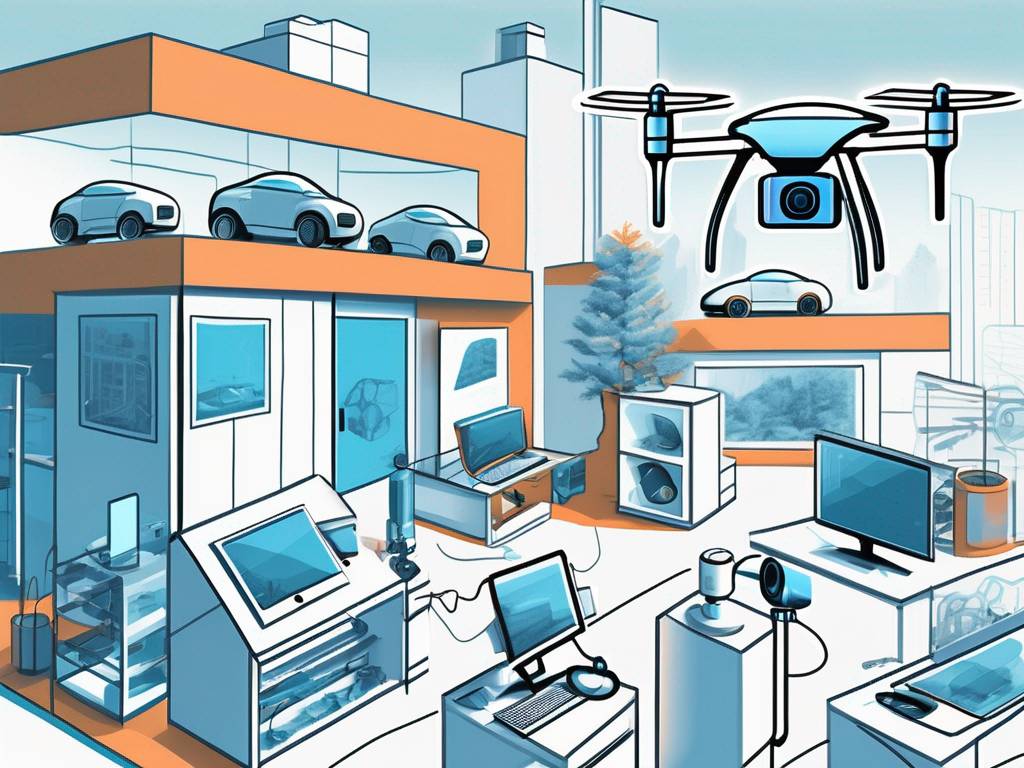AI Applications in Agriculture: Revolutionizing Farming Practices
The integration of artificial intelligence (AI) in various industries has been reshaping traditional practices and revolutionizing productivity. One field that has seen significant advancements through AI implementation is agriculture. The utilization of AI in farming practices has opened up new possibilities for improving efficiency, reducing costs, and ensuring sustainable agricultural practices for the future.
Understanding the Role of AI in Modern Agriculture
AI is an umbrella term that encompasses a range of technologies and applications designed to mimic human intelligence and decision-making processes. In the context of agriculture, AI refers to the use of computer algorithms and machine learning techniques to analyze vast amounts of farm-related data and make informed decisions based on patterns and insights.
The Concept of AI in Agriculture
The concept of AI in agriculture involves the integration of technology to optimize and streamline various farming processes. From crop monitoring and pest control to irrigation systems and predictive analytics, AI applications aim to enhance overall agricultural practices.
One area where AI is making a significant impact is in crop monitoring. Traditional methods of monitoring crops involve manual labor and visual inspection, which can be time-consuming and prone to human error. With AI, farmers can utilize drones equipped with high-resolution cameras and sensors to capture detailed images of their fields. These images are then analyzed by AI algorithms that can detect early signs of plant diseases, nutrient deficiencies, or pest infestations. By identifying these issues early on, farmers can take proactive measures to prevent crop damage and increase yields.
Another aspect of AI in agriculture is pest control. Traditional pest control methods often involve the indiscriminate use of pesticides, which can harm beneficial insects and contaminate the environment. AI-based systems, on the other hand, can analyze data from various sources, such as weather patterns, pest population dynamics, and crop health, to determine the most effective and targeted pest control strategies. This not only reduces the reliance on harmful chemicals but also minimizes the impact on non-target organisms and promotes ecological balance in the farming ecosystem.
The Need for AI in Farming Practices
The need for AI in farming practices arises from several factors. Firstly, the global population is continuously increasing, putting pressure on the agricultural sector to produce more food with fewer resources. As arable land becomes scarce and water resources become limited, farmers need innovative solutions to optimize their production and minimize waste. AI offers the potential to analyze vast amounts of data, such as soil composition, weather patterns, and crop performance, to provide farmers with actionable insights and recommendations for resource allocation and management.
Additionally, climate change and environmental concerns necessitate more sustainable farming practices. Extreme weather events, shifting rainfall patterns, and rising temperatures pose significant challenges to traditional farming methods. AI can help farmers adapt to these changes by providing real-time weather forecasts, enabling them to adjust irrigation schedules and optimize water usage. Furthermore, AI algorithms can analyze historical climate data and predict future trends, allowing farmers to make informed decisions about crop selection and planting schedules.
AI can also contribute to the development of precision agriculture, which involves the use of technology to tailor farming practices to specific areas within a field. By analyzing data from sensors, satellites, and drones, AI algorithms can create detailed maps of soil fertility, moisture levels, and crop health. This information can then be used to apply fertilizers, water, and other inputs precisely where they are needed, reducing waste and optimizing resource utilization.
AI has the potential to revolutionize modern agriculture by providing farmers with advanced tools and insights to optimize their practices. From crop monitoring and pest control to resource management and climate adaptation, AI applications offer innovative solutions to address the challenges faced by the agricultural sector. As technology continues to advance, the role of AI in agriculture is expected to expand, leading to increased efficiency, sustainability, and productivity in food production.
The Intersection of AI & Farming: A Closer Look
By delving into specific AI applications in agriculture, we can gain a deeper understanding of how this technology is transforming and optimizing farming practices.
As the world population continues to grow, the demand for food is also increasing. This puts immense pressure on farmers to produce more crops efficiently and sustainably. Fortunately, artificial intelligence (AI) is revolutionizing the agricultural industry by offering innovative solutions to age-old challenges.
AI-Driven Crop Monitoring
Crop monitoring has traditionally relied on manual labor and periodic field inspections. However, with the advent of AI, farmers now have access to advanced technologies that can significantly enhance their crop monitoring capabilities.
One such technology is the use of aerial drones equipped with advanced imaging techniques. These drones can fly over vast fields, capturing high-resolution images of crops from above. The AI algorithms then analyze these images in real-time, providing farmers with valuable insights into the health and growth patterns of their crops.
With this real-time data, farmers can identify and address potential issues promptly. For example, AI algorithms can detect nutrient deficiencies in plants, allowing farmers to adjust their fertilization practices accordingly. Similarly, AI can identify signs of diseases or pest infestations, enabling farmers to take immediate action to prevent further damage.
Precision Agriculture: The AI Advantage
Precision agriculture is a farming approach that combines AI with other technologies such as global positioning system (GPS) and sensors to digitally analyze and manage agricultural practices at a granular level.
One of the key advantages of AI in precision agriculture is its ability to optimize crop planting patterns. By analyzing various factors such as soil composition, humidity levels, and weather data, AI algorithms can determine the most suitable areas for planting different crops. This optimization ensures that each crop receives the ideal conditions for growth, leading to higher yields.
Additionally, AI can also optimize water usage in precision agriculture. By analyzing data from sensors placed in the fields, AI algorithms can determine the precise amount of water needed for each crop. This targeted approach minimizes water wastage and ensures that crops receive just the right amount of irrigation, reducing the overall environmental impact of farming.
Another area where AI excels in precision agriculture is fertilization scheduling. By analyzing soil data and crop growth patterns, AI algorithms can determine the optimal timing and dosage of fertilizers. This precision ensures that crops receive the necessary nutrients at the right time, maximizing their growth potential while minimizing the use of fertilizers.
The intersection of AI and farming is transforming the agricultural landscape. From AI-driven crop monitoring to precision agriculture, this technology offers farmers unprecedented insights and optimization opportunities. As AI continues to advance, we can expect even more innovative applications that will further enhance farming practices and contribute to sustainable food production.
The Impact of AI on Farming Efficiency
The integration of AI technologies in various farming aspects has the potential to significantly improve overall efficiency and resource management. With the advent of artificial intelligence, farmers now have access to advanced tools and systems that can revolutionize the way they approach agriculture.
AI in Irrigation Systems
One area where AI plays a crucial role is optimizing irrigation systems. AI algorithms can analyze data from sensors that measure soil moisture levels and environmental conditions to determine precise watering schedules. This targeted approach reduces water waste, ensures optimal hydration for crops, and helps conserve water resources.
AI-powered irrigation systems can adapt to changing weather patterns and adjust watering schedules accordingly. By continuously monitoring weather forecasts and analyzing historical data, these systems can make real-time decisions to optimize water usage. This not only benefits the environment but also helps farmers save costs on water bills.
AI in Pest & Disease Detection
Pests and diseases pose significant threats to crop health and yield. Traditional methods of pest and disease detection often rely on manual inspections, which can be time-consuming and prone to human error. However, with the introduction of AI-powered image recognition technology, farmers now have a more efficient and accurate way of identifying potential issues.
AI algorithms can analyze images of plants or field samples to identify early signs of infestation or disease. By detecting issues at an early stage, farmers can take immediate corrective actions, minimizing crop damage and avoiding widespread loss. This not only improves crop yield but also reduces the need for excessive pesticide use, leading to a more sustainable and environmentally friendly farming practice.
AI can also assist in predicting and preventing pest outbreaks. By analyzing historical data, weather patterns, and pest behavior, AI algorithms can provide farmers with valuable insights and recommendations on when to implement preventive measures. This proactive approach can significantly reduce the risk of pest infestations and minimize the use of chemical pesticides.
In addition to pest and disease detection, AI can also help farmers in identifying nutrient deficiencies in crops. By analyzing data from soil samples and plant tissue tests, AI algorithms can provide accurate recommendations on the type and quantity of fertilizers needed. This targeted approach ensures that crops receive the necessary nutrients for optimal growth, reducing waste and increasing overall efficiency.
The integration of AI technologies in farming has the potential to revolutionize the industry. From optimizing irrigation systems to detecting pests and diseases, AI offers farmers advanced tools and systems that can significantly improve efficiency, reduce resource waste, and promote sustainable practices. As AI continues to evolve, its impact on farming efficiency will only grow, leading to a more productive and sustainable agricultural sector.
The Future of AI in Agriculture
As AI continues to evolve and improve, its potential in agriculture is boundless. The future of AI in farming holds immense promise for transforming traditional practices and addressing emerging challenges.
One area where AI is making significant strides is in predictive analytics in farming. AI’s ability to analyze vast amounts of data and identify patterns allows for the development of predictive analytics models. These models can provide insights into crop yield forecasts, market trends, and optimal resource allocation. By leveraging AI, farmers can gain a deeper understanding of their fields and make more informed decisions. For example, AI can help farmers identify the optimal time to plant crops based on weather patterns and historical data, leading to higher yields and more efficient resource usage.
AI’s role in sustainable agriculture is becoming increasingly important. With the growing focus on sustainable farming practices, AI can play a vital role in ensuring environmentally friendly and efficient agricultural operations. By integrating AI systems with renewable energy sources, such as solar panels and wind turbines, farmers can reduce their reliance on fossil fuels and decrease greenhouse gas emissions. Additionally, AI can optimize resource allocation by analyzing data on soil quality, weather conditions, and crop requirements. This enables farmers to minimize water usage, conserve natural resources, and minimize environmental impact while maximizing productivity.
AI can also assist farmers in pest and disease management. By analyzing data from sensors, drones, and satellite imagery, AI algorithms can detect early signs of pest infestation or crop diseases. This early detection allows farmers to take proactive measures, such as targeted spraying or crop rotation, to prevent the spread of pests and diseases. By reducing the use of pesticides and minimizing crop losses, AI contributes to both environmental sustainability and economic viability.
In addition to its direct impact on farming practices, AI also has the potential to revolutionize supply chain management in agriculture. AI-powered systems can optimize logistics, inventory management, and transportation routes, ensuring that crops reach markets efficiently and with minimal waste. This not only benefits farmers by reducing costs and improving profitability but also contributes to overall food security by minimizing post-harvest losses.
As AI continues to advance, there are also exciting possibilities for robotic automation in agriculture. AI-powered robots can perform tasks such as planting, harvesting, and weeding with precision and efficiency. This reduces the need for manual labor and enables farmers to focus on higher-level decision-making and innovation. Furthermore, robots equipped with AI algorithms can continuously monitor plant health, soil conditions, and weather patterns, providing real-time data to farmers and enabling them to make timely adjustments to optimize crop growth.
The future of AI in agriculture is bright and full of potential. From predictive analytics to sustainable farming practices, AI is revolutionizing the way we grow food. By harnessing the power of AI, farmers can make more informed decisions, reduce environmental impact, and increase productivity. As technology continues to advance, we can expect AI to play an increasingly crucial role in shaping the future of agriculture.
Overcoming Challenges in Implementing AI in Agriculture
Although AI offers extensive potential benefits in agriculture, there are challenges that need to be addressed to ensure successful implementation.
Addressing Data Privacy Concerns
As AI relies on vast amounts of data, ensuring data privacy and security becomes paramount. Implementing robust data protection measures, complying with regulations, and promoting transparency can help build trust among farmers and stakeholders, enabling the adoption of AI technologies in agriculture.
Ensuring AI Accessibility for Small-scale Farmers
While large-scale agricultural operations may have the resources to invest in AI technologies, small-scale farmers may face barriers to adoption, including cost, technical expertise, and access to infrastructure. Initiatives aimed at providing affordable AI solutions, user-friendly interfaces, and training programs can bridge the gap and ensure that AI’s benefits are accessible to all farmers, regardless of farm size.
AI applications in agriculture are revolutionizing farming practices by optimizing efficiency, improving resource management, and enabling sustainable agricultural operations. From crop monitoring to precision agriculture, AI’s integration in farming processes offers invaluable insights, enabling better decision-making and increased productivity. As AI continues to progress, the future of agriculture looks promising, with predictive analytics and sustainable practices leading the way.

 hello@westlink.com
hello@westlink.com  (866) 954-6533
(866) 954-6533  700 N Colorado Blvd,
700 N Colorado Blvd,







Comments